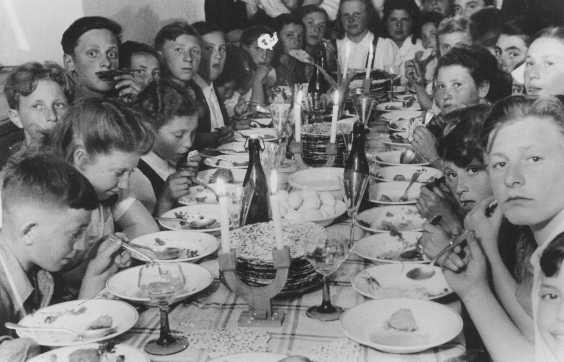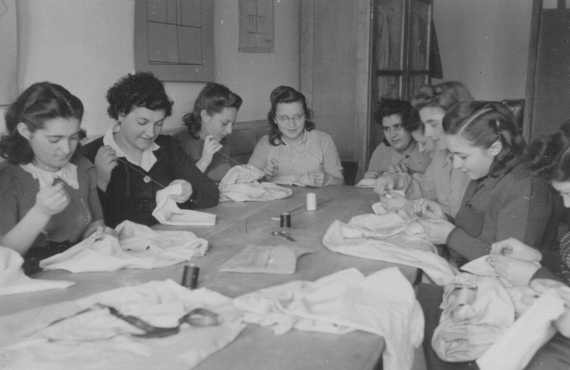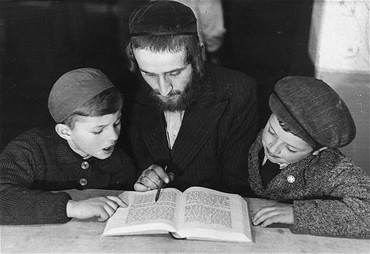
Landsberg Displaced Persons Camp
For the Jews who survived the Holocaust, the end of World War II brought new challenges. Many could not or would not return to their former homelands, and options for legal immigration were limited. In spite of these difficulties, these Jewish survivors sought to rebuild their shattered lives by creating flourishing communities in displaced persons camps in Germany, Austria, and Italy. In an unparalleled six-year period between 1945 and 1951, European Jewish life was reborn in camps such as Landsberg.
Background
The Landsberg displaced persons (DP) camp was located in Landsberg am Lech, near Munich, in the American zone. During the war, it had been a Wehrmacht (German Army) compound and barracks, named Saarburg Kaserne. Initially, the camp housed both Jewish DPs and non-Jewish deportees from East European countries who had been sent to the area by the Nazis to do forced labor. But the camp’s Jewish American commandant, Irving Heymont, insisted that the camp become solely a Jewish DP camp, which happened in the autumn of 1945.
Residents
When the Anglo-American Committee of Inquiry visited Landsberg in early 1946, it found no children between the ages of one and five living there. Irving Heymont wrote to his wife in mid-1945:
With few exceptions, the people of the camp themselves appear demoralized beyond hope of rehabilitation. They appear to be beaten both spiritually and physically, with no hopes or incentives for the future.
But the population of 5,000 Jewish DPs in Landsberg had not been defeated, and within months had created one of the most flourishing communities in the Sh'erit ha-Pletah. Landsberg eventually grew into the second largest DP camp in the American zone. The population, chiefly comprised of Russian, Latvian, and Lithuanian survivors, also gained great influence over other DP camps in the American zone.
Life in the Camp
Beginning in October 1945, the Landsberger Lager Cajtung (Landsberg Camp Newspaper) developed a reputation as one of the best newspapers in the American zone. In 1946, the newspaper's name was changed to the Jidisze Cajtung (Jewish Newspaper), a testament to its renown in the Sh'erit ha-Pletah.
In addition, Landsberg profited from a group of capable leaders whose guidance aided both the camp and the entire Sh'erit ha-Pletah. The most prominent of these leaders was Samuel Gringauz, who served as chairman of the Council of the Central Committee of Liberated Jews in the US zone. Gringauz also served as founding editor of the Landsberger Cajtung. In October 1945, David Ben-Gurion, head of the Zionist organization in Palestine, visited Landsberg and was instrumental in acquiring more space for the overpopulated camp.

Landsberg was also the site of the field headquarters of ORT (Association for the Promotion of Skilled Trades). ORT operated several schools there alongside Landsberg's extensive educational system which ran from preschool through college. This system included several children's schools, eight training farms, a Talmud Torah (religious elementary school), and a Klausenburger yeshiva (religious academy). The focus was to provide an opportunity for DPs to prepare for “Eretz Israel.”
Landsberg also supported a mikvah (Jewish ritual bath), a kosher kitchen, and a radio station. The camp had a rich cultural life that included a theater, cinema, and a Hatzomir choir. Samuel Bak, a Polish survivor who became a famous artist, lived in Landsberg after the war. Landsberg was also the setting of a 1948 feature film entitled Lang ist der Weg (released in English as Long is the Road), written by Israel Becker. The film was shot on location at the Landsberg camp and includes documentary war footage.

Landsberg had the first non-elected camp committee for DPs, which included a police force and a Society for the Observance of the Sabbath. The camp began preparing kosher meat early in 1946, when 2,643 Orthodox Jews registered for kosher beef in Landsberg.
Closure
Landsberg was scheduled to be closed on October 15, 1950, but about 1,100 DPs still remained. The camp was finally shut down sometime between November 1950 and April 1951.
Critical Thinking Questions
What challenges did survivors face in the DP camps?
What challenges did the Allies face in establishing and supervising DP camps?
What responsibilities do (or should) other nations have regarding refugees from war and genocide?

